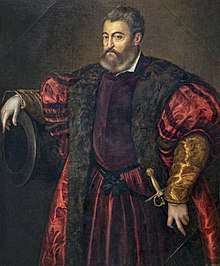Follis (ball)
Follis, a term used in the Ancient Rome, or Ball of Wind (pilota de vent), a term used in the 15th and 16th centuries in Spain and Italy,[1] was a hollow ball, inflated with air under pressure, which allowed the ball to jump and bounce when impacting at a certain speed with any solid body.[2] The different types of balls of wind were commonly used to play a variety of ball games that were popular on that particular period of time.[3][4]
Today, although many of the existing balls are inflated with air, the modern name is simplified to "ball," regardless of the system.
History

There are studies that deal with this issue in some depth, citing numerous documents from famous authors (Alfonso X of Castile who banned the "juego de pelota" with imprisonment, Desiderius Erasmus, Rabelais, Calderon de la Barca, Baltasar de Castiglione, Antonio da Salò Scaino).[5][6]
The ancient Greeks played ball but it is documented that they used balls wind but it seems likely. At time of the Roman Empire had balls wind, with the larger balls called "follis" and the smaller balls called "follicis." The air chamber was made of animal bladders, preferably that of a pig.[7]
When mentioning the Mesoamerican Ballgame (specifically Mexican) chroniclers used to compare the different consistency of the indigenous caoutchouc solid balls with the European air-filled balls.[8][9]
One of the most important testimonies as regarding to the details, is the one by Luis Vives (1493-1540). Vives wrote a comparison between the Jeu de Paume (played with hard balls and rackets with gut stringing -although it means "played with te palm") and the Spanish ball game (similar to the actual pilota valenciana and played with "balls of wind".[10][11] struck with the palm of the hand).
In his testimony, Joan Lluís Vives explains the Jeu de Paume comparing the strings of the racquet from that game, played in Paris with drones gut of the sixth string of a guitar.[10] The demands of a tennis racket stringing regard to the determine the strings of animal intestine are well suited for this use.
According to a book of 1840, Barcelona had a place for playing a "joc de pilota", but it is not clear what kind of game or games were played in that place.[12]
The arrival of the discovery of rubber and synthetic polymers similar properties allowed an improvement in the performance of many games and sports balls.
Scaino Antonio and his work on the ball game
At the request of Alfonso d'Este, Antonio da Salò Scaino[5] (priest, theologian and writer) wrote a remarkable work on the ball game.[13] With reference balls of wind, he described in detail how the bladder and the small tube and a kind of Check valve (or retention) based packing, allowing the bellows to properly inflate the ball in a similar way of the one being used today. He also mentioned the habit of adding some wine inside the chamber so the balls could keep its characteristics (its flexibility) over the time.[14] The system of "Check valve" employed in the balls of wind made of bladder, was described by Juan Valverde de Amusco and "Fray Luis de Granada."[15][16]
Construction
The usual ball of wind was the bladder of an animal. Its outer surface was coated with leather and, once covered, the bladder was filled with air under pressure, using a dedicated type of bellows to inflate it.
See also
References
- "Palazzo della Pilotta web". Archived from the original on 2017-05-07. Retrieved 2016-12-09.
- Diccionari catalá-castellá-llatí- frances-italiá (1839). Diccionari catalá-castellá-llatí-frances-italiá, per una societat de Catalans. pp. 480–.
- Pere Labernia (1861). Diccionario de la lengua castellana, 1: con las correspondencias catalana y latina. Librería de Estevan Pujal. pp. 257–.
- Diccionari de la llengua catalana ab la correspondencia castellana y llatina, 2. Espasa Germans. 1865. pp. 343–.
- Trattato del giuoco della palla di messer Antonio Scaino da Salò, diuiso in tre parti. Con due tauole, l'vna de' capitoli, l'altra delle cose piu notabili, che in esso si contengono
- Història del "jeu de paume".
- Jean-Rodolphe d' Arnay (1802). Vida privada de los romanos. la Viuda de Ibarra. pp. 60–.
- Gonzalo Fernández de Oviedo; Real Academia de la Historia (España) (1851). Historia general y natural de las Indias, Islas y Tierra-Firme del Mar Oceano: Primera parte. Imprenta de la Real Academia de la Historia. pp. 166–.
- Bernardino de Sahag-n; Carlos Maria de Bustamante (27 January 2011). Historia General de las Cosas de Nueva España. Cambridge University Press. pp. 291–. ISBN 978-1-108-02584-3.
- Gonzalo Fernández de Oviedo; Real Academia de la Historia (España) (1851). Historia general y natural de las Indias, Islas y Tierra-Firme del Mar Oceano: Primera parte. Imprenta de la Real Academia de la Historia. pp. 166–.
- Bernardino de Sahag-n; Carlos Maria de Bustamante (27 January 2011). Historia General de las Cosas de Nueva España. Cambridge University Press. pp. 291–. ISBN 978-1-108-02584-3.
- Fernando Patxot (1840). Manual del viajero en Barcelona. Francisco Oliva. pp. 181–.
- Jacopo Bonfadio (1790). Lettere. pp. 28–.
- Antonius Scaino (1555). Trattato del giuoco della palla. - Vinegia, Giolito de Ferrari 1555. Giolito de Ferrari. pp. 144–.
- Juan Valverde de Amusco; Salamanca; Lafréry; Blado, Marcellin (1556). Historia de la composicion del cuerpo humano, escrita por Ioan de Valuerde de Hamusco. impressa por Antonio Salamanca. pp. 3–.
- La anatomía humana en la obra de Fray Luis de Granada: discurso leído el día 14 de mayo de 1946, con motivo de su recepción pública. Real Academia Nac. Medicina. 1946. pp. 46–. GGKEY:763CPEW2J29.